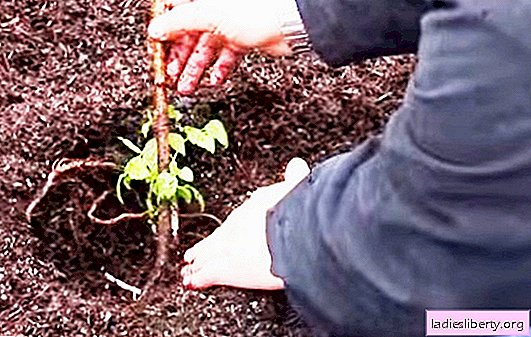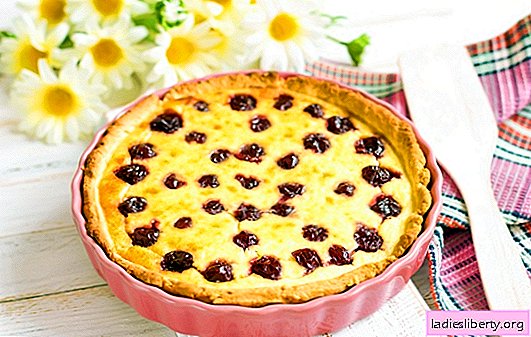
Proper organization of raspberry cultivation greatly simplifies the care of it and increases the number of crops. Therefore, among other rules of gardeners, a recommendation should be made to plant raspberries in the fall. In this case, in the spring, the shoots will not waste time adapting to a new place and immediately all efforts will be directed to the growth of seedlings and berries, which is especially important if planting raspberry raspberries are planted in the fall.
Advantages and disadvantages of planting raspberries in the fall
The landing technique itself always remains unchanged - in spring it is held or in autumn. The main difference is only in the survival of seedlings in a new place. To understand when it is best to plant, you need to know what happens to the plant in these seasons.
Spring is a period of intensive growth of the whole flora - she wakes up from hibernation and the intensive movement of juices begins on the stems and trunks of plants. For the same reason, pruning is never performed in the spring. In spring, there is an increased growth of the aerial parts of the plant and it draws moisture and nutrients from the roots that are extracted from the soil.
If the roots do not have time to take root in a new place, then they will poorly cope with the nutrition of raspberry bushes, and the latter will develop slowly.
In autumn, the situation is exactly the opposite - the number of juices needed by the stem is reduced to a minimum, and the root system is prepared for wintering, so almost all useful substances remain in it. If you plant raspberries in the fall, before the onset of cold weather, the root system will strengthen in a new place, and with the onset of spring everything will be directed to the growth of the bush itself and berries on it.
Weather variability should also be considered. - if it often rains in the fall and the temperature is rarely hot, in the spring noticeable changes occur even during the day, not to mention some kind of stability for a week or a month.
The only drawback of autumn raspberry planting is revealed here. - you need to monitor the time and weather - so that after the bush has been transplanted to a new place, at least a month will pass before the onset of frost. During this time, the root will harden and be ready for wintering.
Perhaps even more of everything said relates to the planting of remont raspberries in the fall. These are its varieties that bear fruit several times during the season and spring “hunger strikes” will become especially noticeable for her if a transplant is made at this time of the year.
Choosing a site for planting raspberries in the fall
Raspberry itself is a fairly unpretentious plant. It can grow almost everywhere, but when breeding it is advisable to follow some rules for finding a site for cultivation.
• The soil. The best option for raspberries is chernozem - ideally, its leached loamy type, characterized by high moisture capacity.
• Location of the site. It is advisable to choose a place closed from the winds, from which snow will not blow out in winter. Sweeter raspberries grow in the sun, so it’s better not to divert shaded areas.
• Moisture. On the one hand, raspberries love moist soil, but here you have to look for a middle ground - if the groundwater in the area comes close to the surface, which causes moisture stagnation in the upper layers of the soil, then this will badly affect the nutrition of plants. Therefore, it is necessary to select a site with good natural drainage, which will ensure a constant influx of nutrients.
• What's next door. Here it is important not so much the ability of other plants to “pull” food from the soil onto themselves, but how susceptible they are to the same diseases as raspberry itself. It is better not to plant it near strawberries, potatoes or tomatoes, despite the fact that they pull different minerals from the soil and do not jam each other. If any of the plants gets sick, then the sore can spread to its neighbors.
Note! To prevent raspberries from growing spontaneously, it is recommended to plant sorrel along the perimeter of the site - it creates an acidic environment that prevents the roots from growing in its direction.
Ground preparation for raspberry planting in autumn
When a site is selected, it must be prepared. It is advisable to do this in advance.
• The ground is leveled, loosened or dug up.
• A ditch about a meter wide and a depth on the bayonet of a shovel is dug along its entire length. If there is a need to prevent the growth of raspberries from the trench made, then you can cover its walls with slate sheets or similar material.
• Pour wood at the bottom of the resulting ditch, preferably those that have already begun to rot. On top of them pour a layer of manure, humus or just fallen leaves or grass, and then add everything with chernozem. Thus, under raspberries there will be a constant source of plant nutrients.
• When the land settles, you may have to add more black soil, after which the site will be ready for planting.
A selection of raspberry seedlings
Here we must proceed from the fact that the primary task will be to strengthen the roots in a new place. Accordingly, when choosing seedlings, one should not be guided by strong stems, but by a developed root system. When planting, it is even recommended to cut the seedlings so that they are about 20-30 cm long.
Raspberries should be planted, the bushes of which will no longer grow this season. To determine its condition, one must pay attention to the leaves and the formation of buds. With foliage, everything is simple - when the bush "leaves" it falls off, but you need to look at the buds: depending on the raspberry variety, they can ripen from mid-September to late October. In contrast to the "spring" buds, these do not bloom after formation, but rather, close, preparing for winter frosts. With the onset of heat, they are ready to bloom and raspberries do not need to waste time nor their ripening.
Raspberry sapling with sleeping buds

Features planting remontant raspberries in autumn and its wintering
In fact, there aren’t much big differences - ordinary raspberries and remontantas are planted according to a similar algorithm. The only thing that needs to be taken into account is that repairing varieties are the result of selection and require a bit more attention.
What you have to decide on the spot, this is a way of landing - you can use a bush or tape. In the first case, single holes are dug and seedlings are planted in it. But for repair raspberries, the tape method is more suitable when a trench is dug into which seedlings are placed at regular intervals. The direction of the tapes is chosen taking into account the movement of the sun, so that the plant is constantly illuminated by it.
Tape method of planting raspberries

Then the seedlings are gently covered with earth, while observing that the roots do not bend up. After planting, raspberries mulch or drip.
Wintering of ordinary and remont raspberries varies significantly. In the first case, the tops must be tied closer to the ground, since this part is most susceptible to freezing. With repair raspberries, this will not be necessary, since all of its second shoots before wintering are simply cut off. In addition, this guarantees that next year there will be no pests on the site that can often wait for winter in the shoots of plants.











